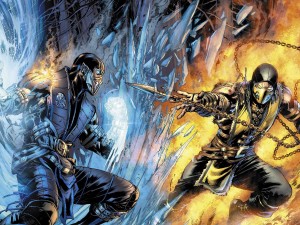“Finish him!” – with two words, “Mortal Kombat” forever changed the landscape of video games and popular culture.
Centered around a series of fight-to-the-death tournaments where the best fighters from the world’s multiple realms battle for supremacy, “Mortal Kombat” set a new standard for video game violence and even caused the congressional hearings that created the video game rating system.
The twelfth and final paper issue of the “Mortal Kombat X” comic book series, based on the video game of the same name, hit shelves Wednesday, completing the final three chapters of the comic that were previously released in digital format.
The series, written by Shawn Kittelsen, introduced the newest generation of “kombatants” – NetherRealm Studios’ first new characters in almost a decade – and sated fans’ bloodlust as they eagerly awaited the game’s release. While not spectacular, Kittelsen’s comic was a loving treatment of the series that focused more on pleasing its existing fan base than growing it.
Released in April 2015, “Mortal Kombat X” was the best-selling video game in the first half of 2015. Set two decades after the events of “Mortal Kombat 9,” the newest installment of the video game series explores the strained relationship between Earthrealm, Outworld and the Netherrealm, and features a host of new characters alongside fan favorites. The comic fills in the gap between the “Mortal Kombat X” game and its predecessor, “Mortal Kombat 9,” with a story about the uneasy alliance between Earthrealm and Outworld.

The comic series’ greatest strength lies in its artwork; however, the quality of the art varies by artist. The drawings by Dexter Soy and Daniel Sampere are the most intricate and captivating, while those of Igor Vitorino try too hard to appear realistic, resulting in faces that are either distorted or lacking in detail.
Beheading and disembowelment are common fates, and blood is spilt with reckless abandon. The fights are, as expected, the most enjoyable parts of the series, especially the age-old clash between Scorpion and Sub-Zero. While fatalities do not translate nearly as well on paper as on screen, each issue contains enough gore to satisfy even the most vicious of fans.
While DC Comics fully embraces the gratuitous violence in “Mortal Kombat” with beautiful spreads and panels, Kittelsen’s stories often fall flat. Tension is forcefully manufactured by teasing the deaths of characters who the readers know will survive because of the characters’ inclusion in the game’s roster.
Indeed, Kittelsen’s comic feels like too much fan service: It is almost impossible for those not familiar with the “Mortal Kombat” mythos to appreciate. Not enough time is spent introducing existing characters like drunken master Bo’ Rai Cho or blind swordsman Kenshi. Some old characters only appear in brief cameos, resulting in little impact on casual fans and those new to the “Mortal Kombat” universe.
Kittelsen was vocal in promoting the role that the new “kombatants” would play in the story. His focus lies mainly on the descendants of existing cast members like Cassie Cage, rather than on the more interesting figures whose stories are not explored much in the game like mercenary gunslinger Erron Black. The video game’s story already revolves around Cage’s team of Earthrealm fighters, so Kittelsen’s area of focus seems a wasted opportunity to explain and further develop the mythos of other new characters.
While the prominence of the series’ most iconic figures like Scorpion, Sub-Zero and Johnny Cage was likely meant to please returning fans and ease in new ones, the series as a whole fails to add any new depth to their personalities. Kittelsen relies too heavily on established tropes and doesn’t even attempt to venture into new territory. People already know Scorpion struggles with rage and guilt, Johnny Cage is a conceited B-list actor and capable warrior, and Sub-Zero is a wise martial arts grandmaster who freezes people.
With the publication of “Mortal Kombat X #12,” the king of fighting games takes a bow out of the pop culture spotlight after an extraordinarily successful run – at least until NetherRealm releases the game’s second expansion in the first half of 2016.
If anything, the comic proved the series’ viability outside of the video game medium and just how glorious it is to see Scorpion dominate Sub-Zero across pages of vibrant ink drawings. Despite its flaws, the comic, coupled with the game, showed surprising innovation and breathed new life – or rather death – into the 20-year-old series.
Fatality lives.
– Matthew Fernandez
